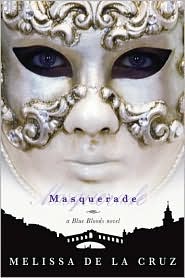
De La Cruz, Melissa. Masquerade. Hyperion: 2007. ISBN: 9780786838936.
Summary:
The social and financial elite of New York City are not who we think they are. They are Blue Bloods, immortal vampires that have been around since the fall of Lucifer. This second installment of the Blue Blood series fills in the blanks about Schuyler and her fellow students at the Duchesne School. Masquerade opens with Schuyler and her human conduit, Oliver, searching for her long lost grandfather. As Cordelia, her grandmother lay dying, she insisted that Schuyler find him because he would know what to do about the Silver Bloods. The Silver Bloods are evil vampires who have aligned with Lucifer and kill Blue Bloods. Schuyler and Oliver find Lawrence, her grandfather, but he initially refuses to help. After changing his mind, Lawrence moves back to New York City and begins the search for the Silver Bloods.
Evaluation:
Intelligent and suspenseful, Melissa De La Cruz captures the reader and takes us on a journey that is paranormal, but not ridiculous. Good and evil exist in the human world and the paranormal world and its effects are the same; death and destruction. One of the interesting things about this book is the historical snippets that the author includes. Each Blue Blood cycles through different human lifetimes and usually plays a significant role in a historical context. This second installation of the saga has more sex, but it is all implied. The author does not give us details which is refreshing. As a reader our imagination has an active role.
Reader's Annotation:
Even among vampires there is good and evil.
Bibliotherapeutic Uses:
Sometimes our lives can be so awful and stressful that it is helpful to escape. When physical escape is not an option, a good book can take us away, and give us a break.
Genre:
Paranormal/Vampires
Why I Included This Book:
I really don't like paranormal fiction. Surprisingly I like the first book, so I decided to read the second in the series.













